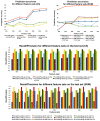Predicting a small molecule-kinase interaction map: A machine learning approach
- PMID: 21708012
- PMCID: PMC3151211
- DOI: 10.1186/1758-2946-3-22
Predicting a small molecule-kinase interaction map: A machine learning approach
Abstract
Background: We present a machine learning approach to the problem of protein ligand interaction prediction. We focus on a set of binding data obtained from 113 different protein kinases and 20 inhibitors. It was attained through ATP site-dependent binding competition assays and constitutes the first available dataset of this kind. We extract information about the investigated molecules from various data sources to obtain an informative set of features.
Results: A Support Vector Machine (SVM) as well as a decision tree algorithm (C5/See5) is used to learn models based on the available features which in turn can be used for the classification of new kinase-inhibitor pair test instances. We evaluate our approach using different feature sets and parameter settings for the employed classifiers. Moreover, the paper introduces a new way of evaluating predictions in such a setting, where different amounts of information about the binding partners can be assumed to be available for training. Results on an external test set are also provided.
Conclusions: In most of the cases, the presented approach clearly outperforms the baseline methods used for comparison. Experimental results indicate that the applied machine learning methods are able to detect a signal in the data and predict binding affinity to some extent. For SVMs, the binding prediction can be improved significantly by using features that describe the active site of a kinase. For C5, besides diversity in the feature set, alignment scores of conserved regions turned out to be very useful.
Figures










Similar articles
-
Seminal quality prediction using data mining methods.Technol Health Care. 2014;22(4):531-45. doi: 10.3233/THC-140816. Technol Health Care. 2014. PMID: 24898862
-
Binding Activity Prediction of Cyclin-Dependent Inhibitors.J Chem Inf Model. 2015 Jul 27;55(7):1469-82. doi: 10.1021/ci500633c. Epub 2015 Jul 10. J Chem Inf Model. 2015. PMID: 26079845
-
SVM-Fold: a tool for discriminative multi-class protein fold and superfamily recognition.BMC Bioinformatics. 2007 May 22;8 Suppl 4(Suppl 4):S2. doi: 10.1186/1471-2105-8-S4-S2. BMC Bioinformatics. 2007. PMID: 17570145 Free PMC article.
-
Training based on ligand efficiency improves prediction of bioactivities of ligands and drug target proteins in a machine learning approach.J Chem Inf Model. 2013 Oct 28;53(10):2525-37. doi: 10.1021/ci400240u. Epub 2013 Sep 24. J Chem Inf Model. 2013. PMID: 24020509
-
A feature-based approach to predict hot spots in protein-DNA binding interfaces.Brief Bioinform. 2020 May 21;21(3):1038-1046. doi: 10.1093/bib/bbz037. Brief Bioinform. 2020. PMID: 30957840
Cited by
-
In silico Methods for Design of Kinase Inhibitors as Anticancer Drugs.Front Chem. 2020 Jan 8;7:873. doi: 10.3389/fchem.2019.00873. eCollection 2019. Front Chem. 2020. PMID: 31970149 Free PMC article. Review.
-
Ensemble learning method for the prediction of new bioactive molecules.PLoS One. 2018 Jan 12;13(1):e0189538. doi: 10.1371/journal.pone.0189538. eCollection 2018. PLoS One. 2018. PMID: 29329334 Free PMC article.
-
Predicting the outcomes of organic reactions via machine learning: are current descriptors sufficient?Sci Rep. 2017 Jun 15;7(1):3582. doi: 10.1038/s41598-017-02303-0. Sci Rep. 2017. PMID: 28620199 Free PMC article.
-
Exploring the Potential of Spherical Harmonics and PCVM for Compounds Activity Prediction.Int J Mol Sci. 2019 May 2;20(9):2175. doi: 10.3390/ijms20092175. Int J Mol Sci. 2019. PMID: 31052500 Free PMC article.
-
Identification of functional modules by integration of multiple data sources using a Bayesian network classifier.Circ Cardiovasc Genet. 2014 Apr;7(2):206-17. doi: 10.1161/CIRCGENETICS.113.000087. Circ Cardiovasc Genet. 2014. PMID: 24736851 Free PMC article.
References
-
- LaValle SM, Finn PW, Kavraki LE, Latombe JC. Efficient database screening for rational drug design using pharmacophore-constrained conformational search. Proceedings of the third annual international conference on computational molecular biology, RECOMB'99, April 11-14, Lyon, France. 1999. pp. 250–260.
LinkOut - more resources
Full Text Sources
Other Literature Sources
Miscellaneous

